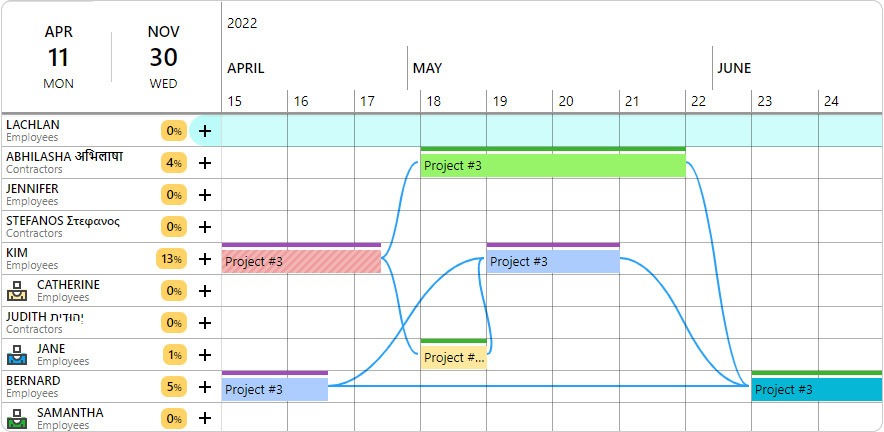Resource allocation is the answer to better, more successful project portfolio management.
How? Well, when you’re juggling multiple projects at once, the practice is imperative to not only ensure capacity, but eliminate any bottlenecks and delays. And project managers know that in the world of PPM, little issues add up quickly. Becoming big problems before you know it.
So if your project portfolio begins to lack focus, with schedules beginning to get off track, then you know you have yourself the start of something. And it may be time to revaluate what’s going on behind the scenes and make some adjustments. Especially when the alternative is so much worse: resource allocation syndrome. A real condition and a major challenge to effective multi-project management.
That’s why to ensure that your own project and resource portfolio is running smoothly, we’ll take a look at some actionable steps that may make all the difference. Plus explore how resource allocation syndrome may already be sneaking into project management processes. As well as a few ways you can fix it yourself, to get projects back on schedule.
Defining Resource Allocation
In project management, resource allocation is the process of assigning assets (in this case resources – people, tools, equipment, rooms) to specific activities (tasks, projects) and time periods. You may also see it go by another name, resource scheduling.
The primary aim of resource allocation is to ensure that all projects have the right capacity, and the right resources doing the job. All so projects can be delivered on time and with success. Why is this important? Let’s take a look at a few scenarios.
How Are You Managing Resources in your Portfolio?
Every project manager has their process and tools for scheduling resources for projects, so it’s impossible to say if there’s a right way or a wrong way. But, there is most definitely a better way. Take a look at a couple of examples and try to guess which one is which.
The First Scenario:
On a Monday, after drafting up a general report, you find that while one of your team members is clearly overbooked for the week with tasks from 4 different projects. The good news is there is another team member with the same skillset, who doesn’t have any tasks until Thursday. So, you shuffle things around. By reallocating the second resource to the projects that the first one is working on, and balancing out everyone’s workload. Great, huh?
The Second Kind of Resource Allocation
Now, consider this kind of resource allocation.
After an intense meeting with the management, you draft up a report. They said that you must make Project X a priority. From the report, you see that there aren’t any free human resources to allocate to the project. To hell with it, a priority is a priority.
You move things around. So, you allocate some people from Project Y and Project Z. They’ll have to get acquainted with the new project eventually, right? But while this happening, their current tasks are put on hold. Projects Y and Z both suffer. Not so great, is it?
The Case of Needing a Better Overview
If the resource allocation you are doing is mostly the first case, you’re probably doing just fine. And you’re probably already using a good resource capacity planner which provides an overview of resource availability across the portfolio.
If you are doing the second type of resource allocation more than you would like to admit, you probably have a serious case of resource allocation syndrome. Don’t worry, you are not alone.
The Consequences of Poor Planning: Resource Allocation Syndrome
Research has shown that resource allocation syndrome is a pretty common problem across the industries. In fact it is seen as the prime challenge to effective multi-project management.
When resource allocation syndrome arises, one can be pretty sure that there is a profound flaw in the way the whole organization is used to deal with managing multiple projects with the same resource pool.
Since it’s such a universal problem for those that deal with project portfolio management it might even seem like that’s the way it’s supposed to be. But you know what? It doesn’t have to be that way. Resource allocation shouldn’t be a retroactive fix to a problem that can be avoided with a bit of a mentality change in your organization. And there is something you can do about it.
What happens when resources aren’t allocated properly
Improper resource planning and resource allocation syndrome can lead to some pretty severe consequences. Here’s a few ways your project portfolio can be negatively affected:
- Project delays
- Double-booking resources
- Over-utilization and under-utilization of resources
- Unclear project priorities
- Conflicts in the resource schedule
- Resource wastage
- Projects routinely going over budget
- Communication problems within team
- Problems with clients and project stakeholders
Tips for Optimizing Resource Allocation
You can fix your resource allocation syndrome yourself by taking the following steps. Here’s what you should do:
Run an Analysis of Current and Future Capacity
Before taking on new projects, analyze the status of ongoing projects and the availability of your resources. Winning new contracts is important. Do you know what’s even better? Successfully finishing the ones you already have. That’s one of the biggest things that is overlooked. You can only take on new projects if there are enough resources available. It’s as simple as simple and complicated as that.
How Can PPM software Help:
With the help of resource portfolio management software, it’s much simpler to complete an analysis, since all your data is in one place to begin with. Then all you need to do is run a resource report. You’ll not only have a clearer picture of portfolio’s resource pool, but you’ll see which projects are causing the most trouble currently. So you can begin to sort that out with additional capacity. Reports are also a great way to plan future capacity. As you’ll have the historical data to plan more accurately.
Get an Overview of the Resource Pool
Many project managers might not deal with getting to know their resource pool. And with good reason! As with some higher-level planning, there’s no reason to dive into those details. Or if there’s thousands of resources, it might just be too hard to learn all the skillsets, or their strengths and weaknesses.
But in order to ensure a smooth transition between project demands and phases, PPMs should know their resources and their projects. Because scheduling the right person for the job is the best way to guarantee that the work is done right and on time.

How Can PPM software Help:
PPM software can help you get acquainted to your resource pool and project portfolio. But you don’t have to memorize it all! Instead, built-in features like custom data fields will help you keep your data sorted. Data fields allow you to include info to your resources and projects regarding skills, certifications, location, work type, and more. This makes it easy to find a project that matches a resource’s skillset or strength.
Plus, if you have a lot of resources to allocate, these same data fields can be a handy way to filter out the unnecessary ones and just concentrate building the perfect project team.
Plan for the Unexpected
Things go wrong, so take it into account while planning. Don’t be optimistic. In project portfolio management, it’s not a good quality to have. Rather, have a fair amount of pessimism in you. It’s also fair to say that the work is never done. And if you’re going into a new project expecting a one-and-done kind of planning, then you might want to rethink your career path. That’s not to say there aren’t a few ways to make it easier on yourself.
How Can PPM software Help:
If you use a portfolio resource management tool, and you have a good overview, it will be easier to notice the places where holdups are hidden. So nothing gets overlooked. Ensuring you don’t miss anything while planning and you don’t have to reallocate later.
Plus, a solid overview of the entire portfolio will show you how tied up your resources are with other projects. As well as letting you know how on track you are with deadlines. Monitoring KPIs along the way will also help you stay on course. But using software, it’s a lot easier to not only define KPIs but see how it’s all progressing. And if you ever do veer off course, it’s a lot easier to get back on with some quick reallocation.
Prioritize Before, Not During.
With every new project, you should always know the which project is the top dog. It may be frustrating to see that some projects are getting more or “better” resources, while others are getting what’s left over. But at the end of the day, over-utilized resources is not a solution. So, know your priorities and act accordingly. And all of this is easier to do before you’re in the middle of a tough project where the only focus is putting fires out constantly. That’s where strategic prioritization in PPM can come in handy.
How Can PPM software Help:
Before diving into something new, it’s best to get your ducks in a row. Drafting a project communication plan is a good first step. After that software can help make those plans a reality. Diving into a single project one at a time, can ensure that nothing is overlooked in the process. With PPM software, it’s possible to not only see the entire portfolio overview, but you can also dig into singular project specifics.
Ganttic for Allocation Optimization

When it comes to effective project portfolio management, the best advice we can give is not to overlook your resources. Sorting out capacity and setting priorities from the get-go will guarantee that the projects get delivered and it’s all done with less stress.
By equipping yourself with an online project portfolio management tool for resource management you’re setting yourself and your portfolio up for success. With Ganttic, you’ll have an overview of your project portfolio as well as the resources scheduled for project tasks. The software has everything you need for better portfolio management and features to fight resource allocation syndrome, including: